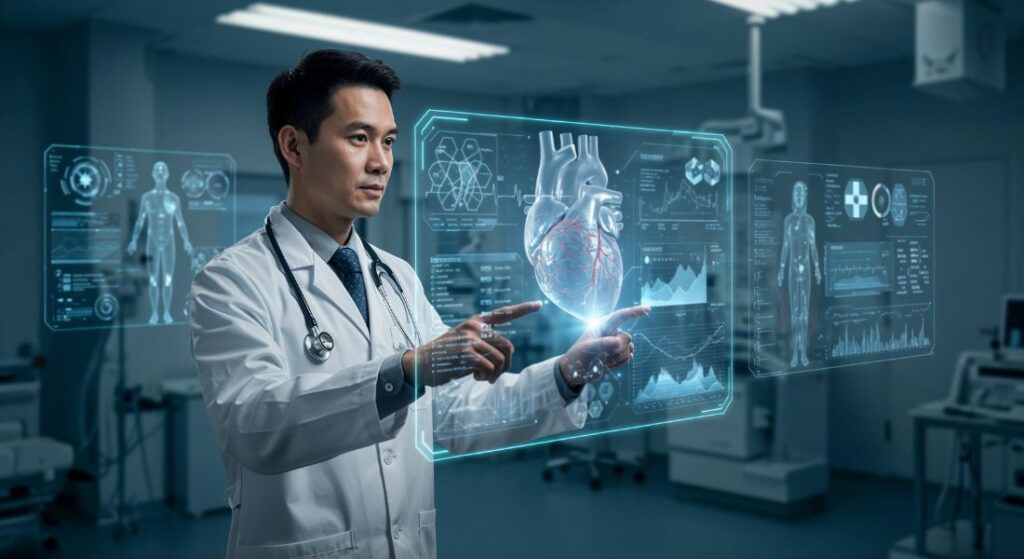Walk into any busy clinic, and you’ll see it nurses juggling charts, doctors clicking through endless screens, staff chasing down lab results. It’s not that they aren’t doing their jobs well; it’s that the systems meant to help them are… well, a little stuck in the past.
Now imagine if your Electronic Health Records didn’t just store information but actively worked with you almost like a quiet partner in the background, predicting your next move, flagging risks, and saving you hours of tedious work. That’s the promise of AI-powered EHR systems, and it’s not science fiction anymore. It’s happening in clinics and hospitals right now.
What Are AI-Powered Electronic Health Records?
At their simplest, Electronic Health Records Software is a digital version of a patient’s chart — medical history, allergies, prescriptions, lab results, the works. But when you integrate Artificial Intelligence, the game changes.
Instead of passively holding data, AI-enabled EHRs interpret it. They can spot unusual patterns in lab work, suggest the right billing codes, even pull up relevant research for a rare condition. It’s like having a sharp, never-tired assistant who knows your patients as well as you do.
I spoke to a physician last month who said her AI-powered EHR “saved her” during flu season. Why? It flagged patients at higher risk for complications before they even came in, so she could adjust care plans in advance. That’s the kind of practical, everyday impact we’re talking about.
Key Benefits for Healthcare Providers
If you’ve ever left the clinic after a 12-hour shift wondering why you spent more time on the computer than with patients, you’ll appreciate what AI-powered systems bring:
- Less Paperwork, More Care – Automated charting, coding, and order entry mean fewer late nights catching up.
- Better Clinical Accuracy – Predictive alerts help catch potential issues early.
- Happier Patients – Smart portals keep patients in the loop with test results, reminders, and secure messages.
- True Data Sharing – Interoperability features let you access complete patient records from anywhere.
- Smarter Scheduling – AI can help balance patient loads and reduce no-shows.
It’s not about replacing the human touch it’s about clearing the clutter so providers can focus on the human part of medicine.
Latest Trends & Innovations in EHR and AI
The EHR conversation in 2025 isn’t just about “going digital.” It’s about making data actually work for healthcare teams. Here’s what’s leading the charge:
1. Cloud-Based EHRs
More practices are ditching on-site servers for cloud-based systems. Why? They scale easily, update automatically, and can be accessed securely from anywhere whether that’s the ICU or your kitchen table.
2. Predictive Analytics
Think of this as your system’s crystal ball. AI models can analyze massive data sets to forecast patient risks, predict seasonal surges, or even flag potential drug interactions before they happen.
3. Decision Support at Your Fingertips
Instead of digging through reference books (or Google), built-in AI tools surface relevant treatment guidelines right in the patient record.
4. Telehealth Integration
Video visits and remote monitoring aren’t going anywhere. Modern EHRs are weaving these services into the same interface where in-person care is documented.
5. Voice-First Documentation
Some providers are now documenting visits hands-free, letting voice tools transcribe and organize notes automatically.
How AI Medical Scribes Fit into the Picture
Even the smartest EHR still needs data to work with and entering that data takes time. This is where Understanding AI Medical Scribes comes in.
These tools listen in on the patient visit (securely, of course), transcribe the conversation, and drop neatly structured notes into the EHR before you’ve even left the exam room. One urgent care physician I know calls it “the best coworker I’ve never had to train.”
When paired with an AI-powered EHR, the result is a workflow where you focus on listening and problem-solving, while the tech handles the admin side.
Choosing the Right Electronic Health Records Software
Not all systems are built equally, and switching EHRs can be a heavy lift. If you’re shopping around, look for:
- Built-In AI Tools – Predictive alerts, smart scheduling, and decision support should be part of the package.
- Cloud Hosting – For flexibility, automatic updates, and disaster recovery readiness.
- Interoperability Standards – HL7 FHIR compliance ensures your system can “talk” to others.
- Ease of Use – A clean interface matters more than you think frustrated staff won’t use clunky tools.
- Security You Can Trust – HIPAA compliance, encryption, and user-level access controls are non-negotiable.
In short: pick a system that grows with you, not one you’ll outgrow in two years.
Common Challenges (and How to Get Past Them)
Sure, adopting AI in your EHR isn’t without its bumps:
- Data Privacy Worries – Partner with vendors who are transparent about security protocols.
- Integration Headaches – Choose platforms with proven API connections to your existing tools.
- Staff Learning Curve – Roll out features in stages and pair new users with tech-savvy “super users.”
- Budget Concerns – Calculate ROI based on time saved, errors prevented, and patients retained.
The takeaway? Most roadblocks are manageable with the right vendor and an implementation plan that doesn’t try to do everything on day one.
Wrapping It Up
The future of healthcare isn’t just digital it’s intelligent. AI-powered Electronic Health Records take the mountains of patient data we already have and make it useful, actionable, and, frankly, less of a headache.
If your practice is ready to cut down on after-hours charting, improve patient care, and step confidently into the next era of medicine, this is a technology worth exploring sooner rather than later.
FAQs
1. How is AI different from regular EHR features?
Traditional EHRs record and store patient information. AI-powered EHRs go further — analyzing that information, spotting trends, and making proactive suggestions.
2. Will using AI in my EHR put patient privacy at risk?
Reputable vendors follow strict HIPAA guidelines and use encryption, role-based access, and audit trails to keep patient data safe.
3. Can AI medical scribes replace human scribes?
Not entirely. They can handle the bulk of documentation, but complex cases may still need human oversight for accuracy.
4. Do cloud-based EHRs work if my internet goes down?
Many have offline modes that store data locally until the connection is restored, so you won’t lose your notes mid-visit.
5. Is switching to an AI-powered EHR expensive?
There’s an initial investment, but the long-term savings in staff time, error reduction, and improved patient retention can more than offset it.



